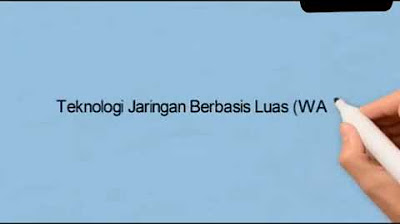Geografi Kelas XI (20) Mobilitas Penduduk | Migrasi Penduduk | Perpindahan Penduduk
Summary
TLDRThis educational video script discusses the concept of population mobility, defining it as the geographical movement of people from one area to another over a certain period. It differentiates between permanent mobility, including international and national migration, and non-permanent mobility, such as commuting and circular migration. The script aims to enhance understanding of these demographic movements, using clear examples and inviting viewers to engage with questions and comments.
Takeaways
- 📚 The video is an educational resource discussing population mobility for 11th-grade students, but also suitable for 10th and 12th graders.
- 🌐 Population mobility is defined as the geographical movement of people from one area to another within a certain time frame.
- 🔄 There are two types of population mobility: permanent and non-permanent, with permanent mobility also known as migration.
- 🌍 Permanent mobility is further divided into international and national migration, involving moving across countries or within the same country, respectively.
- 🚶♂️ International migration is split into immigration, emigration, and remigration, which involve moving to another country, leaving one's own country, and returning to one's home country, respectively.
- 🏙️ National migration includes transmigration, urbanization, and ruralization, which are government programs to redistribute population, moving from rural to urban areas, and vice versa.
- 🏘️ Transmigration specifically refers to moving people from densely populated areas to less populated areas within the same country.
- 🌆 Urbanization is the movement of people from villages to cities for various reasons, such as work.
- 🛣️ Ruralization is the opposite of urbanization, where people move from cities back to villages to settle.
- 🛌 Non-permanent mobility, also known as circulation, involves temporary movement of people without the intention to settle, such as commuting and circular migration.
- 🚗 Commuting is a type of non-permanent mobility where people travel to work or study in another area and return within 24 hours.
- 🏨 Circular migration refers to temporary stays in a destination area, not intended for permanent settlement, and includes activities like seasonal work or temporary assignments.
Q & A
What is the main topic discussed in the video script?
-The main topic discussed in the video script is population mobility, specifically for 11th-grade students, but also relevant for 10th and 12th graders.
What is the definition of population mobility according to the script?
-Population mobility is defined as the movement of people from one geographical area to another within a certain period of time.
What are the two main types of population mobility mentioned in the script?
-The two main types of population mobility mentioned are permanent mobility and non-permanent mobility.
What is the term used for permanent population mobility?
-Permanent population mobility is also referred to as migration.
How is international migration differentiated from national migration?
-International migration involves crossing national borders, while national migration occurs within the same country.
What are the three types of international migration mentioned in the script?
-The three types of international migration mentioned are immigration, emigration, and remigration.
What does emigration mean in the context of international migration?
-Emigration refers to the act of people leaving one country to settle or reside in another country.
What is the term used for people who move to another country with the intention to settle there?
-People who move to another country with the intention to settle are referred to as immigrants.
What is remigration and how does it differ from immigration and emigration?
-Remigration refers to the return of people to their original place of residence or homeland, as opposed to immigration and emigration which involve moving to a new country.
What are the three types of national migration mentioned in the script?
-The three types of national migration mentioned are transmigration, urbanization, and ruralization.
What is the purpose of transmigration according to the script?
-The purpose of transmigration is to redistribute the population from densely populated areas to less populated areas within the same country, often as a government program to prevent concentration in one area.
What is the difference between urbanization and ruralization?
-Urbanization is the movement of people from rural areas to cities, while ruralization is the opposite, referring to the movement of people from cities to rural areas.
What are the two types of non-permanent population mobility mentioned in the script?
-The two types of non-permanent population mobility mentioned are commuting and circular migration.
What is commuting in the context of non-permanent population mobility?
-Commuting refers to the daily movement of people from their residence to a workplace in another area and back, typically within a 24-hour period.
What is circular migration and how is it different from commuting?
-Circular migration is the movement of people from one area to another with the intention of staying temporarily, involving overnight stays at the destination, but not with the intention of permanent settlement.
Outlines

Dieser Bereich ist nur für Premium-Benutzer verfügbar. Bitte führen Sie ein Upgrade durch, um auf diesen Abschnitt zuzugreifen.
Upgrade durchführenMindmap

Dieser Bereich ist nur für Premium-Benutzer verfügbar. Bitte führen Sie ein Upgrade durch, um auf diesen Abschnitt zuzugreifen.
Upgrade durchführenKeywords

Dieser Bereich ist nur für Premium-Benutzer verfügbar. Bitte führen Sie ein Upgrade durch, um auf diesen Abschnitt zuzugreifen.
Upgrade durchführenHighlights

Dieser Bereich ist nur für Premium-Benutzer verfügbar. Bitte führen Sie ein Upgrade durch, um auf diesen Abschnitt zuzugreifen.
Upgrade durchführenTranscripts

Dieser Bereich ist nur für Premium-Benutzer verfügbar. Bitte führen Sie ein Upgrade durch, um auf diesen Abschnitt zuzugreifen.
Upgrade durchführenWeitere ähnliche Videos ansehen

Vlog #29 - Nations, States, & Nation States

Pengertian Mobilitas Sosial dan Faktornya

XI TKJ _ TEKNOLOGI JARINGAN BERBASIS LUAS Pemahaman Dasar Jaringan Berbasis Luas (WAN) Part 1

memahami korespondensi satu satu kelas 8

Lecture 02: Impairment of Loans Receivable. Receivable Accounting. [Intermediate Accounting]

Ciri-ciri Makhluk Hidup | IPA | SayaBisa
5.0 / 5 (0 votes)
